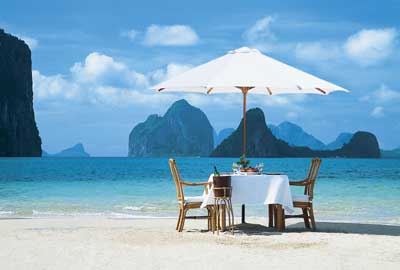 Unfold one of the Philippines’ best kept secret, Palawan’s Calamian group of islands where in the midst lies Coron.
Unfold one of the Philippines’ best kept secret, Palawan’s Calamian group of islands where in the midst lies Coron.Discover pristine coves with limestone cliffs, teeming with swallows and palawan red hornbills. Snorkel in its marine rich coral reefs with unbelievable underwater visibility.
The quality of the sea water in this part of the Philippine archipelago is believed to be most ideal for cultured south sea pearls. Pearl farms are in the vicinity but their location are strictly classified.
Experience a safari in the middle of a tropical setting. Witness giraffes, zebras and gazelles running freely in the Calauit Wildlife Sanctuary. Trapped in time? These animals were brought to this island courtesy of the Marcos family in the early ‘80’s.
After a long day of sea and sand frolic, you can treat yourself to a hot spa courtesy of mother nature, the Makinit Hot springs. Free-flowing hot mineral rich salt water trapped in a man-made pool will surely soothe your weary bones.
A dip in this pool will relax tense and soothe aching muscles. Rejuvenated , one is ready for another day of adventure in Coron. There are many secrets awaiting to be disclosed.

 grew up in the city, but I consider my self a taga-baybayon (coastal dweller) at heart. My siblings and I have very fond memories of life by the sea as we spent most of our childhood summers in Baclayon. This is a coastal town in Bohol, where my mother grew up. It is also the mainland town right across Pamilacan Island, now controversial for its whale shark-hunting practices. My great, great grandparents had a big old house right beside the sea, with only the huge and ancient mangroves, pagatpatan, standing between them and the vast blue yonder.
grew up in the city, but I consider my self a taga-baybayon (coastal dweller) at heart. My siblings and I have very fond memories of life by the sea as we spent most of our childhood summers in Baclayon. This is a coastal town in Bohol, where my mother grew up. It is also the mainland town right across Pamilacan Island, now controversial for its whale shark-hunting practices. My great, great grandparents had a big old house right beside the sea, with only the huge and ancient mangroves, pagatpatan, standing between them and the vast blue yonder.
 About 1768 islands bordered by the South China Sea and the Sulu Sea to the East side. The land area is 1.5 mill hectares and it's Philippine’s largest province with a coastline of almost 2000 km and the island is 650 km long
About 1768 islands bordered by the South China Sea and the Sulu Sea to the East side. The land area is 1.5 mill hectares and it's Philippine’s largest province with a coastline of almost 2000 km and the island is 650 km longThe warmest period of the year is from March to May. The coolest period is from December to February and the heaviest rainfall is usually from July to August.
Population of the island province is about 750,000 of which 130,000 live in Puerto Princesa, the capital city of this province.
Palawan is home to cobra, python, monitor lizards wandering around St. Paul's cave, huge scorpions, mouse deer, bearcat, Palawan Peacock Pheasant, Great Kingfisher and the Palawan Eagle, Sea Turtle and Dugongs.
The province is also home to several indigenous tribes - Tagbanua, Palaweños, Batak, Tau’t Bato, Tau’t Daram. Native born Palaweños include Cuyunons, Agutaynons and Molbags.

 Palawan is an island province of the Philippines located in the MIMAROPA region. Its capital is Puerto Princesa City, and it is the largest province in the country in terms of total area of jurisdiction. The islands of Palawan stretch from Mindoro in the northeast to Borneo in the southwest. It lies between the South China Sea and the Sulu Sea. The province is named after its largest island, Palawan Island, measuring 450 kilometers (280 mi) long, and 50 kilometers (31 mi) wide.
Palawan is an island province of the Philippines located in the MIMAROPA region. Its capital is Puerto Princesa City, and it is the largest province in the country in terms of total area of jurisdiction. The islands of Palawan stretch from Mindoro in the northeast to Borneo in the southwest. It lies between the South China Sea and the Sulu Sea. The province is named after its largest island, Palawan Island, measuring 450 kilometers (280 mi) long, and 50 kilometers (31 mi) wide.
 Palawan is composed of the long and narrow Palawan Island, plus a number of other smaller islands surrounding the main island. The Calamianes Group of Islands, to the northwest consists of Busuanga Island, Culion Island, and Coron Island. Durangan Island almost touches the westernmost part of Palawan Island, while Balabac Island is located off the southern tip, separated from Borneo by the Balabac Strait. In addition, Palawan covers the Cuyo Islands in the Sulu Sea. The disputed Spratly Islands, located a few hundred kilometers to the west is considered part of Palawan by the Philippines, and is locally called the Kalayaan Group of Islands.
Palawan is composed of the long and narrow Palawan Island, plus a number of other smaller islands surrounding the main island. The Calamianes Group of Islands, to the northwest consists of Busuanga Island, Culion Island, and Coron Island. Durangan Island almost touches the westernmost part of Palawan Island, while Balabac Island is located off the southern tip, separated from Borneo by the Balabac Strait. In addition, Palawan covers the Cuyo Islands in the Sulu Sea. The disputed Spratly Islands, located a few hundred kilometers to the west is considered part of Palawan by the Philippines, and is locally called the Kalayaan Group of Islands.